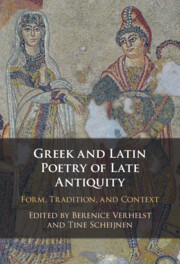Book contents
- Greek and Latin Poetry of Late Antiquity
- Greek and Latin Poetry of Late Antiquity
- Copyright page
- Contents
- Figures
- Contributors
- Introduction
- Part 1 A ‘Late’ Perspective on the Literary Tradition
- Part 2 Late Antique ‘Genres’ and ‘Genre’ in Late Antiquity
- Part 3 The Context of Late Antiquity
- Chapter 8 Saying the Other
- Chapter 9 Internal Audiences in the New Testament Epics of Juvencus and Nonnus
- Chapter 10 Colluthus and Dracontius
- Chapter 11 Objects of the Lusting Gaze
- Chapter 12 Metamorphosis and Mutability in Late Antique Epic
- Bibliography
- General Subject Index
- Index Locorum
Chapter 9 - Internal Audiences in the New Testament Epics of Juvencus and Nonnus
from Part 3 - The Context of Late Antiquity
Published online by Cambridge University Press: 16 June 2022
- Greek and Latin Poetry of Late Antiquity
- Greek and Latin Poetry of Late Antiquity
- Copyright page
- Contents
- Figures
- Contributors
- Introduction
- Part 1 A ‘Late’ Perspective on the Literary Tradition
- Part 2 Late Antique ‘Genres’ and ‘Genre’ in Late Antiquity
- Part 3 The Context of Late Antiquity
- Chapter 8 Saying the Other
- Chapter 9 Internal Audiences in the New Testament Epics of Juvencus and Nonnus
- Chapter 10 Colluthus and Dracontius
- Chapter 11 Objects of the Lusting Gaze
- Chapter 12 Metamorphosis and Mutability in Late Antique Epic
- Bibliography
- General Subject Index
- Index Locorum
Summary
Nonnus’ Paraphrase of the Gospel of John lacks a proem in which the author advances the main poetic aims of the poem and gives his intended audience a brief guide to its reading. On the contrary Juvencus’ Evangeliorum libri quattuor includes a number of programmatic spaces (especially the proem and final lines), which have been extensively analysed and related to similar paratexts in other Bible epics. This chapter proposes a new take on the question of the intended audience and possible proselytising aim of these two poems by means of a reading of the reactions to Jesus and his gospel as paradigms for how these poets related to their audiences. It pays special attention to their points of contact and divergences, on (1) symbolic images of the audience (Matthew’s parable of the sower, John’s initial Hymn of the logos), (2) introductions of choral characters as they interact with Jesus, and (3) divisions of the audience, which it relates to the specific context of creation of both poems: the Constantinian Latin-speaking West for Juvencus and 430–60 Alexandria, dominated by the figure of Cyril (bishop 412–44), for Nonnus.
Keywords
- Type
- Chapter
- Information
- Greek and Latin Poetry of Late AntiquityForm, Tradition, and Context, pp. 174 - 204Publisher: Cambridge University PressPrint publication year: 2022

